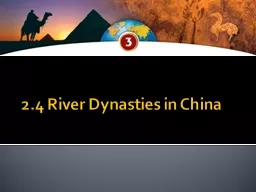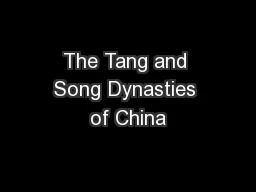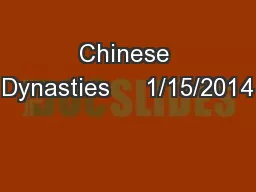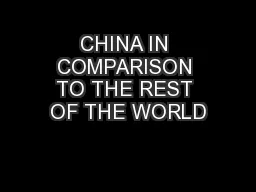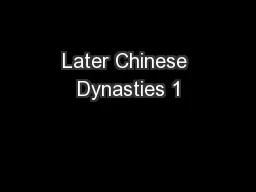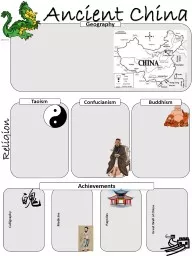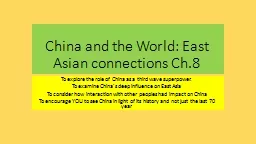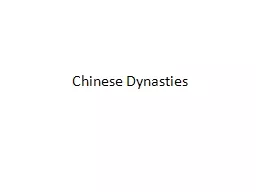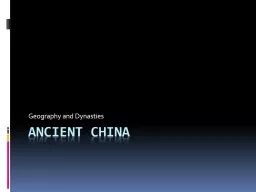PPT-2.4 River Dynasties in China
Author : tatiana-dople | Published Date : 2018-03-07
The Geography of China Barriers Isolate China Ocean mountains deserts isolate China from other areas River Systems Huang He Yellow River in north Yangtze in south
Presentation Embed Code
Download Presentation
Download Presentation The PPT/PDF document "2.4 River Dynasties in China" is the property of its rightful owner. Permission is granted to download and print the materials on this website for personal, non-commercial use only, and to display it on your personal computer provided you do not modify the materials and that you retain all copyright notices contained in the materials. By downloading content from our website, you accept the terms of this agreement.
2.4 River Dynasties in China: Transcript
The Geography of China Barriers Isolate China Ocean mountains deserts isolate China from other areas River Systems Huang He Yellow River in north Yangtze in south Huang He leaves . Wong. ewong5@binghamton.edu. With many thanks to: . Community engagement . program of . 2011. Professor: . Lisa . Yun. Graduate Assistant: Sandy woo . Department of Asian and Asian American studies. Binghamton university. SWBAT. the major political, economic, and cultural developments in Tang and Song China and their impact on Eastern Asia. (4H). The Tang and Song Dynasties of China. Like Western Europe . after . the decline of the . 9.1 Intro . China! Yay! Future Overlords! Yay!. 0.5 What was China like during Unit 3?. Even more powerful than in the Classical Era. Biggest cities in the world. Neighbors felt gravitational pull. Outsiders (through trade and conflict) start to influence it more . Chapter 10 Lesson 1. Chapter 15 Lesson 1. Bell work . answer on page…. 1. What . are the two main rivers of China called?. 2. Describe . on the map where most of the first Chinese cities were located. .. CHINA’S MAJOR CITIES AND NEIGHBOURING COUNTRIES. THE PHYSICAL FEATURES OF ANCIENT CHINA. China’s geography shaped where people settled in prehistory. The country is framed by mountains to the south, deserts to the west and north and two major river valleys in the centre, extending to the east coast. As was the case elsewhere in the world, river valleys provided the best opportunities for hunter gatherers to develop agriculture, farming and settled life.. . Question & Research Task. A . dynasty. is a chain of rulers that originate from one family or group. Chinese history is divided into dynastic periods. The earlier dynasties included the Qin and Han, and a period of disunity. Eventually, the different kingdoms were reunified. Taoism. Calligraphy. Medicine. Pagodas. Great Wall of China. Achievements. Confucianism. Buddhism. Ancient China. Geography. Religion. Taoism. Calligraphy. Medicine. Pagodas. Great Wall of China. Achievements. . Ninth Edition. CHAPTER 13. States and Cultures in East Asia,. 800–1400. Copyright © 2011 by Bedford/St. Martin’s. John P. McKay . ●. Bennett D. Hill . ●. John Buckler. Patricia Buckley Ebrey . San Francisco invented the “. F. ortune Cookie”. 10 million people in China live on less than a US $1 per . day.. 2013 population 1.36 billion- 20% of world’s population. . In Livingston County the cow to human ratio is 18:1.. China made great advances in art, literature, architecture, and technology under the rule of the Tang and Song. Do Now:. What Chinese philosophy was reflected in the Tang government?. . Chinese Empires. Ancient China. Ancient River Valley Civilizations – China . Vocabulary. Ethics. Confucianism. Daoism. Legalism. Jade. Oracle. Lords. Peasants. Geography of Ancient China:. Nearly 4 million square miles. To explore the role of China as a third wave superpower.. To examine China’s deep influence on East Asia. To consider how interaction with other peoples had impact on China. To encourage YOU to see China in light of its history and not just the last 70 year. Archeological discovery of the . Xia. is still in its preliminary stage . Established about 2200 B.C.E. . Legendary King Yu. , the dynasty founder, a hero of flood control . Erlitou: possibly the capital city of the Xia. China. China is the 4. th. largest country in the world today. Most populated country in the world today.. Geographic features isolated China.. Mountain. chains . and deserts separated China from the rest of Asia..
Download Document
Here is the link to download the presentation.
"2.4 River Dynasties in China"The content belongs to its owner. You may download and print it for personal use, without modification, and keep all copyright notices. By downloading, you agree to these terms.
Related Documents

